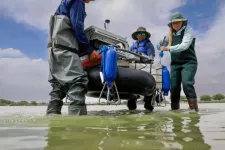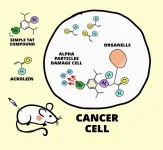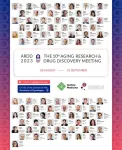(Press-News.org) Copenhagen, Denmark: A new artificial intelligence (AI) tool can identify sperm in severely infertile men in seconds compared to the hours it takes scientists, according to results presented today (Tuesday) at the 39th annual meeting of the European Society of Human Reproduction and Embryology (ESHRE) [1].
The study authors say the algorithm they have developed brings hope to men who want a biological child but have no sperm in their semen.
Currently, these patients must undergo a procedure where a portion of their testes is removed to help them become fathers. Embryologists extract sperm manually from this biopsy sample to fertilise the partner’s eggs through Intracytoplasmic Sperm Injection (ICSI) treatment. It can take up to six hours to find and isolate sperm in human tissue, which can undermine the embryologist’s ability to identify sperm because of mental and physical fatigue.
Data from this new study by Australian experts show trained AI can spare clinicians this arduous process.
Findings show the tool called SpermSearch instantly identifies sperm, then leaves the embryologist to decide whether sperm is really present and if it is viable enough for ICSI. Results show the algorithm is also more accurate than an experienced clinician.
Lead author, Mr Dale Goss, from the University of Technology Sydney, said: “This tool has the ability to give patients who have very little chance of fathering their own biological children an increased chance.
“The algorithm improves antiquated approaches that have not been updated in decades. It will ensure the rapid identification of sperm in samples, which will not only increase the chance of a couple conceiving their own biological children, but also reduce stress on sperm and increase efficiency in the laboratory.”
Around one percent of all men have no sperm in their semen, which is the most severe form of infertility known as non-obstructive azoospermia (NOA). The condition affects around five percent of couples seeking fertility treatment.
To identify sperm for ICSI, embryologists partially shred tissue samples and tease them apart with forceps or fine needles. Any sperm present is then released into a specially prepared liquid which is placed in a petri dish.
With a microscope, the clinician searches through droplets of this liquid, a tiny portion at a time. However, contamination from other cells and particles makes this challenging. If the embryologist misses the sperm, the patient has less opportunity to become a parent, and the longer this takes, the greater the chance the sperm is not viable.
The aim of the study was to test if AI could speed up this process. The research was carried out at an IVF clinic in Sydney in two phases over five months using AI software installed on a computer. The researchers first trained the algorithm by showing it thousands of still microscope photographs. These images featured sperm and high levels of other cells and debris, but only the sperm was highlighted.
This coaching enabled the AI tool eventually to learn through image analysis what a sperm looked like using its own evaluation system that checks and adjusts its performance.
Mr Goss and his team used healthy sperm, and then samples of testicular tissue from seven patients aged from 36 to 55 years. All had been diagnosed with NOA and had already undergone surgical sperm retrieval at the clinic.
The men donated tissue left-over after treatment that had been prepared for sperm retrieval but not needed.
A test was then carried out simultaneously between the algorithm and an embryologist whose precision was considered to be 100%. The researchers compared the time both took to identify sperm and their degree of accuracy.
Results showed that the AI found more sperm overall, although some were only spotted by the embryologist and some by AI alone.
The embryologist found 560 sperm, the AI found 611, and between them they found a total of 688. The algorithm identified sperm for each area of droplet that it viewed in less than a 1000th of the time taken by an embryologist.
It was also more accurate and precise in identifying sperm – the AI tool found 60 more sperm, and it was five percent more accurate than the embryologist per viewable droplet area.
In their conference presentation, the authors highlight that the study is based on a proof-of-concept test and that a clinical trial is required. This is to prove the technique is useful and performs the task of sperm detection with the desired result.
They add that such research should be carried out among men with other forms of severe infertility and who are undergoing other surgical approaches, such as sperm collections from different parts of the testes.
The chair of ESHRE, Professor Carlos Calhaz-Jorge from the Northern Lisbon Hospital Centre and the Hospital de Santa Maria in Lisbon (Portugal), was not involved in this research. He said: "For men diagnosed with non-obstructive azoospermia, ICSI with sperm retrieved from the testicles is the only realistic chance of having biological children. This is a preliminary study on the use of AI for finding healthy sperm in men experiencing this type of infertility.
"Finding healthy sperm under the microscope in fragments of testicular biopsies can be an arduous process. The prospect of using AI to make the process quicker and more accurate is very interesting. We need to see more research to build on these results."
(ends)
[1] Presentation no: O-136, “Artificial intelligence to assist in surgical sperm detection and isolation”, presented by Dale Goss, Session 44: Focal or not Focal Spermatogenesis: That is the question!, Hall D4, 10.15 hrs CEST, Tuesday 27 June 2023.
Notes for editors
According to the UK Academy of Medical Science’s press release labelling system, this is a non-peer reviewed experimental study in people.
Funding: none
When obtaining outside comment, journalists are requested to ensure that their contacts are aware of the embargo on this release.
For further information, contact:
Sophie Goodchild
Email: goodchildsophie@hotmail.com
Mobile: +44 (0)7767 325595
Emma Mason
Email: wordmason@mac.com
Mobile: +44 (0)7711 296986
Kerry Noble
Email: kerry_noble@hotmail.com
Mobile: +44 (0)7446 869 433
Laura Rossignoli at ESHRE
Email: Laura@eshre.eu
Mobile: +32 (0)499 92 32 49
The European Society of Human Reproduction and Embryology (ESHRE) is a European non-profit organisation with international membership, whose main mission is to promote the study and research of reproductive science and medicine as well as the treatment of infertility. Established in 1984, the Society now comprises more than 9.000 members and has become the leading Society in reproductive science and medicine worldwide. Our members are medical professionals, scientists and researchers working in reproductive science, reproductive medicine and embryology. We work in close partnership with the patient organisation Fertility Europe. The ESHRE annual meeting attracts over 11,000 clinicians, researchers, scientists, exhibitors. In 2022, participants from 130 countries attended. Seven of the top ten countries represented were European.
END
Algorithm finds sperm in infertile men faster and more accurately than doctors
2023-06-27
ELSE PRESS RELEASES FROM THIS DATE:
Lupus flare-ups strongly linked to specific bacterial growth in gut
2023-06-27
Recurrent bouts of systemic lupus erythematosus, marked by the body’s immune system attack of its own tissues, closely tracked with measureable upticks in growth in the gut of a certain species of bacteria.
New research from NYU Grossman School of Medicine shows that bacterial blooms of the gut bacterium Ruminococcus blautia gnavus occurred at the same time as disease flare-ups in five of 16 women with lupus of diverse racial backgrounds studied over a four-year period. Systemic lupus erythematosus involves damaging inflammation, especially in the kidneys, but also in joints, skin, and blood vessels. ...
This self-driving boat maps underwater terrain
2023-06-27
EL PASO, Texas (June 27, 2023) – Step aside self-driving cars, self-driving boats are here — and they can do more than take you on a cruise.
Researchers at The University of Texas at El Paso have constructed a fully autonomous boat that can carry out bathymetric surveys — surveys of the depth and terrain of bodies of water like oceans, rivers and lakes. The team hopes the robotic boat can help simplify the survey process, which usually takes a crew of individuals to complete, as well as assist ...
A new generic treatment for multiple types of cancer
2023-06-27
Researchers led by Katsunori Tanaka at the RIKEN Cluster for Pioneering Research (CPR) in Japan and Hiromitsu Haba at the RIKEN Nishina Center for Accelerator-Based Science (RNC) have developed a new technique that has the potential to generically treat several kinds of cancer, with fewer negative side effects than currently available methods. Published on June 27 in Chemical Science, the proof-of-concept study showed that tumors in mice grew almost three times less and survival was 100% after just one injection of a compound that is designed to emit small amounts of alpha radiation from the inside of cancer cells, thus killing them but sparing ...
Why Saudi Arabia's "The Line" isn’t a revolution in urban living
2023-06-27
In October, the excavation work for the superlative construction project began. What some consider an ideal ecological city, others call a promotional gimmick. Researchers from the Complexity Science Hub now show why The Line should not be a showcase for future cities.
"It's the embodiment of the dream to start from scratch and completely rethink a city," says Rafael Prieto-Curiel, who researches cities at the Complexity Science Hub. The Line is planned to be a city built from nothing in the desert. It is to consist of two gigantic, unbroken rows of skyscrapers, with living space in between. 170 kilometers long. 200 meters wide. 500 meters high, higher ...
Magnetic bacteria point the way
2023-06-27
Magnetotactic bacteria, which can align with the Earth’s magnetic field, have been discovered in a new location. Previously observed on land and in shallow water, analysis of a hydrothermal vent has proven that they can also survive deep under the ocean. The bacteria were able to exist in an environment that was not ideal for their typical needs. Magnetotactic bacteria are of interest not only for the role they play in Earth’s ecosystem, but also in the search for extraterrestrial life. Evidence of their existence can remain in rocks for billions of years. Their magnetic inclinations can also provide ...
Over 100 leaders in aging and longevity to present their latest research at the 10th ARDD
2023-06-27
June 27, 2023, the University of Copenhagen is excited to reveal the speakers, program and travel grants for the 10th Aging Research & Drug Discovery Meeting, the World's Largest Conference on Aging Research in the biopharmaceutical industry that will transpire on August 28 - September 1, 2023 on-site at the Ceremonial Hall, University of Copenhagen, and online.
According to the United Nations, the proportion of people aged over 65 now outnumber children younger than 5. The enormous growth in the elderly population is posing a socioeconomic challenge to societies worldwide, and necessitates new sweeping interventions for age-associated ...
A new method to keep thickening agents tiny in transport and big in application
2023-06-27
Osaka, Japan – Many commercial products such as food, cosmetics, and inks contain cellulose nanofiber (CNF) as a thickening agent. However, CNFs have some limitations that prevent their more widespread use. Now, researchers from Osaka University have demonstrated a method of dehydrating CNFs to a dense powder without affecting their three key properties. Their findings are published in Macromolecular Rapid Communications.
Video for your easy understanding
https://youtu.be/PAEd36v_SjI
CNFs are a popular thickening agent because small amounts in water have high transparency, high viscosity, and the viscosity ...
Two technology-based approaches that improved hand hygiene compliance are featured at infection prevention conference
2023-06-27
Orlando, Fla., June 27, 2023 – Hand hygiene is the simplest, most effective way to prevent the spread of infections in healthcare, yet healthcare worker adherence is often low. Infection preventionists at two health systems will present their successful hand hygiene interventions at the Association for Professionals in Infection Control and Epidemiology’s (APIC’s) Annual Conference in Orlando Florida, June 26-28.
University of Michigan Health sustains 95% hospital-wide hand hygiene compliance through creation ...
Updated guidance shows how hospitals should protect patients from resistant infections
2023-06-27
ARLINGTON, Va. (June 27, 2023) — A group of five medical organizations have released updated recommendations for the prevention of methicillin-resistant Staphylococcus aureus, known as MRSA, transmission and infection. MRSA causes approximately 10% of hospital-associated infections in the United States and such infections are associated with an increased risk of death. Certain infections caused by MRSA rose by as much as 41% during the pandemic after falling in preceding years.
Strategies to Prevent Methicillin-Resistant Staphylococcus aureus Transmission and Infection in Acute Care Hospitals provides evidence-based, ...
How secure are voice authentication systems really?
2023-06-27
Computer scientists at the University of Waterloo have discovered a method of attack that can successfully bypass voice authentication security systems with up to a 99% success rate after only six tries.
Voice authentication – which allows companies to verify the identity of their clients via a supposedly unique “voiceprint” – has increasingly been used in remote banking, call centers and other security-critical scenarios.
“When enrolling in voice authentication, ...





